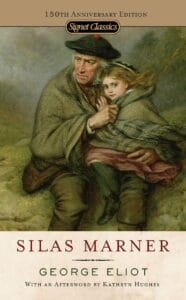
Book Summary
Silas Marner is a wonderful book written by George Eliot. It tells the story of a lonely and sad man named Silas Marner, who lives in a small village called Raveloe. This book is full of exciting adventures, friendship, and the power of love.
Silas Marner is a heartwarming story that teaches us important lessons about kindness and the value of friendship. The book starts by introducing us to Silas Marner, a weaver who is wrongly accused of a crime and forced to leave his old village. He moves to Raveloe, where he lives a lonely life and spends all his time working and counting his gold coins.
One day, something magical happens to Silas. His gold coins are stolen, but instead, he finds a little girl named Eppie in his cottage. Silas decides to take care of her and raises her as his own daughter. Eppie brings so much joy and happiness into Silas’ life, and he becomes a beloved member of the community.
Throughout the book, we see how Silas changes from a sad and isolated man to a loving and caring father. The story also teaches us that true happiness comes from the love and connections we have with others, not from material possessions.
Silas Marner is a beautifully written book that captures the reader’s imagination with its vivid descriptions and engaging characters. The author, George Eliot, skillfully explores themes of redemption, love, and the importance of community.
The story is set in the early 19th century, and the language used may be a little challenging for a third-grader. However, the book’s message of love and friendship is universal and can be understood by readers of all ages.
George Eliot, whose real name was Mary Ann Evans, was a famous English writer. She was born in 1819 and wrote many other well-known books. George Eliot’s writing is known for its deep understanding of human emotions and its realistic portrayal of characters. Silas Marner is one of her most beloved works and continues to be enjoyed by readers around the world.
“Silas Marner: The Weaver of Raveloe” is a novel written by George Eliot, a pseudonym for Mary Ann Evans, and was first published in 1861. The story is set in the early years of the 19th century and revolves around the life of the protagonist, Silas Marner, a weaver who lives in the rural English village of Raveloe. The novel is a profound exploration of the human condition, delving into themes of faith, redemption, and the transformative power of love.
“Silas Marner” is a beautifully crafted narrative that captures the essence of rural life in 19th century England. The story begins with Silas, a man who is wrongfully accused of theft and excommunicated from his religious community in Lantern Yard. He moves to Raveloe, where he lives a solitary life, weaving and hoarding gold. His life takes a dramatic turn when his gold is stolen, and a little girl, Eppie, enters his life.
Eliot’s storytelling is rich and evocative, painting a vivid picture of the pastoral setting and the simple, yet complex lives of its inhabitants. The characters are well-drawn, each with their unique traits and quirks, making them relatable and real. Silas, the misunderstood recluse, Godfrey Cass, the weak-willed squire’s son, and Eppie, the innocent child who brings joy and purpose to Silas’s life, are all characters that stay with you long after you’ve turned the last page.
The plot is engaging, with elements of mystery, drama, and romance. The narrative is interspersed with insightful observations about human nature and society, making it a thought-provoking read. The language, though archaic at times, adds to the charm of the novel and enhances the authenticity of the setting.
“Silas Marner” is a tale of loss and redemption. It explores the theme of isolation and the human need for connection. Silas’s exile from Lantern Yard and his subsequent life in Raveloe is symbolic of his spiritual and emotional isolation. His hoarding of gold is a manifestation of his need for something tangible to hold onto in the absence of human companionship.
The novel also delves into the theme of materialism versus human relationships. Silas’s obsession with his gold is contrasted with his love for Eppie. The gold, which he initially sees as his only source of happiness, loses its value when Eppie enters his life. This shift in Silas’s affections is a commentary on the transient nature of material wealth and the enduring value of human relationships.
Eliot also explores the theme of fate and providence. The series of coincidences that lead to Eppie’s arrival at Silas’s door and the recovery of his gold seem to suggest a divine plan. This raises questions about free will and destiny, adding a philosophical dimension to the story.
The novel is also a social critique of the rigid class hierarchy of 19th century England. The contrast between the affluent Cass family and the humble weaver is a reflection of the social disparities of the time.
George Eliot, whose real name was Mary Ann Evans, was an English novelist, poet, journalist, and translator. She was one of the leading writers of the Victorian era. Her work, known for its realism and psychological insight, explored complex social issues and human relationships.
Eliot was born in 1819 in Warwickshire, England. She adopted the male pen name to ensure her works were taken seriously in an era when female authors were often associated with romantic novels. Her other notable works include “Middlemarch”, “The Mill on the Floss”, and “Daniel Deronda”.
Eliot’s writing was influenced by her wide-ranging interests in philosophy, literature, and social reform. Her novels are celebrated for their detailed character development, intricate plots, and exploration of moral dilemmas. Despite the initial controversy surrounding her personal life, Eliot’s reputation as a writer has endured, and she is now regarded as one of the greatest novelists in English literature.
Don Quixote by Miguel de Cervantes
Miguel de Cervantes
Read Now →